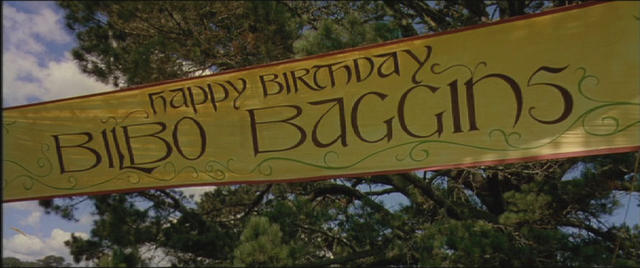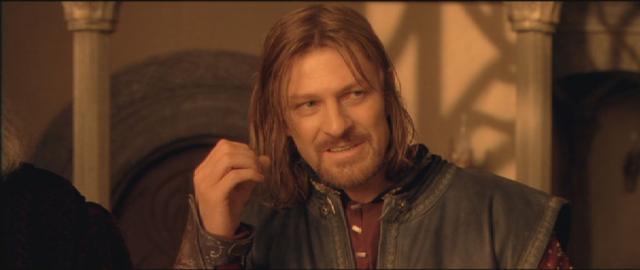This idea came from and article in The Frodo Franchise which in turn was talking about a blog that used this technique.
The idea is to select random screen grabs from a movie and discuss those screen grabs and anything to do with the movie that comes to mind. It occurred to me that it would be an interesting exercise, so I am taking each disk (six in all) from the three films and taking three scenes from each disk. This first blog will take three screen grabs from disk one of The Fellowship Of The Ring. The three I have selected using RANDOM.ORG are at 10, 20 and 98 minutes.
The first screen grab is at 10 minutes.

This is a shot from the party preparations where Bilbo is reciting what he is writing as he begins writing the story of the Hobbit, There and Back Again. Bilbo is talking about Hobbits and this is accompanied by scenes of Hobbit’s everyday life finishing with the preparations for Bilbo’s and Frodo’s birthday. They both have birthdays on the same day, Bilbo’s being 111 and Frodo’s being 33 which coincidentally is considered a Hobbit’s coming of age.
An interesting note is that the actor playing Bilbo, Ian Holm, played Frodo in the 80’s BBC radio adaptation of The Lord Of The Rings.
The narration by Bilbo is a nice warm sequence and a gentle introduction for what is to become later on a very dark story. It also introduces the curious creatures called Hobbits to those who are new to the story in an ingenious manner. It also underlines the upcoming birthday party.
Which brings us neatly to the next screen from the 20 minute mark.
 This is the long awaited party and the same banner features as in the last screen grab. The banner is under the “Party Tree” of which much is made in the book but would be completely missed in the film if you did not know the books. Tolkien had a life long affection with trees and his anthropomorphic representation of the trees speaks to this affection. For Tolkien the destruction of trees speaks of the dehumanising way that industrialisation had dominated his society. He was an ecologist before it was fashionable. The party tree represented the the essential bond between nature and humanity. There is a fleeting reference to this later on in the images in Guardrail’s mirror but it is much stronger in the books.
This is the long awaited party and the same banner features as in the last screen grab. The banner is under the “Party Tree” of which much is made in the book but would be completely missed in the film if you did not know the books. Tolkien had a life long affection with trees and his anthropomorphic representation of the trees speaks to this affection. For Tolkien the destruction of trees speaks of the dehumanising way that industrialisation had dominated his society. He was an ecologist before it was fashionable. The party tree represented the the essential bond between nature and humanity. There is a fleeting reference to this later on in the images in Guardrail’s mirror but it is much stronger in the books.
But for the moment the birthday celebration is yet another representation of the simplicity and earthiness if you will of the Hobbits. It also gives the film makers a good opportunity to introduce a number of important, and some not so important, characters and plot points in this complex story.
The final screen grab is from the 98 minute mark.
 This is from the council of Rivendel. This is a pivotal point in the story. From Tolkien’s point of view this was a turning point for him where the story began to take on an entirely new dimension. It had been growing in his mind and from Bree to Rivendel and at the council particularly it grew from a neat sequel to The Hobbit into the epic it is today.
This is from the council of Rivendel. This is a pivotal point in the story. From Tolkien’s point of view this was a turning point for him where the story began to take on an entirely new dimension. It had been growing in his mind and from Bree to Rivendel and at the council particularly it grew from a neat sequel to The Hobbit into the epic it is today.
From the stories perspective it goes from a neat little tale of Hobbit bravery to a vast tale that encompasses all of the peoples of middle earth. Other races including elves, trolls, men and wizards have alredy been introduced but it is at Rivendel that it all begins to meld into a cohesive story. Again the book has much more detail and far more exposition than can be put into a 12 hour series of movies but here Jackson does a great job of fitting in enough information to inform the viewer without either boring him or overloading his already bulging brain.
This particular scene is even more interesting since we see the beginnings of the seduction of Borimier. He is at this point arguing that the ring should be taken to Minas Tirith for use in the war against Sauron and here is portrayed with all the ambiguity that possesses his character. A great and noble leader of men which is the very thing that the Ring uses to corrupt. The ring is subtle and knows that it cannot use weaknesses but strengths to corrupt. It uses the very thing which makes us great and turns it against us. For Borimier it is his nobility and strength that the ring tempts him with – telling him that it can aid him in his defense of the peoples of middle earth. This was the very thing which Tolkien learnt when he was in the trenches in World War II. It is not a man’s weakness that is his downfall it is his strength.
